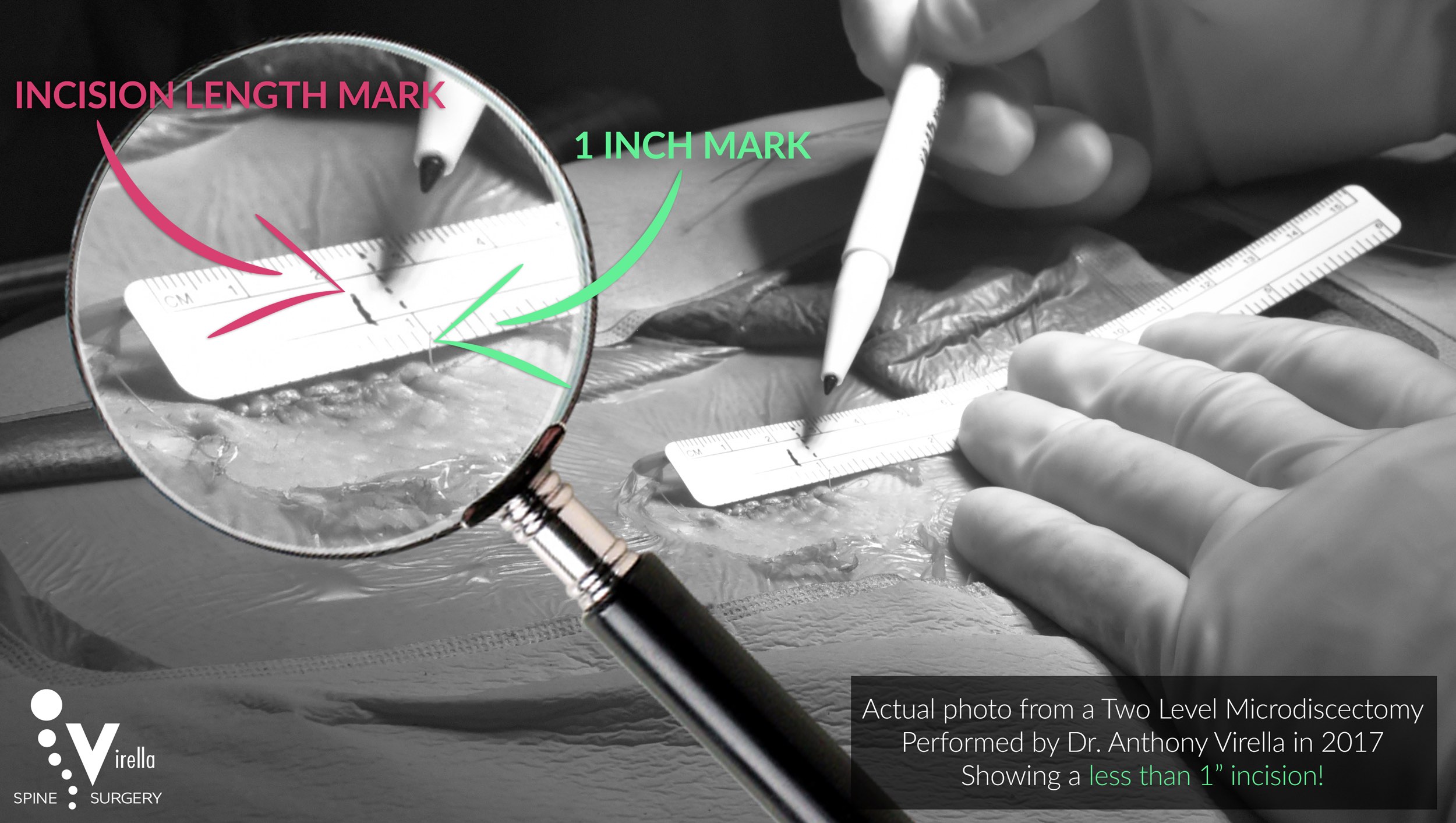Specializing in Minimally Invasive Spine Surgery
Dr. Virella is considered a pioneer in the world of minimally invasive spine surgery, having worked alongside some of the fields leading visionaries, such as Edward C. Benzel MD and Larry T. Khoo MD. While at UCLA, Dr. Virella worked hand in hand with Dr. Khoo, developing and refining most of the minimally invasive spine surgery techniques that are used worldwide today. This also included involvement in some of the very first minimally invasive lumbar interbody fusions that were performed on the West Coast. His research at UCLA also included work on 3D-Iso CT technologies and spinal image guidance.
Benefits of Minimally Invasive Spine Surgery
Only 10 years ago, if you had spine surgery, you could expect it to take as much as one year before you would be able to return to normal activities. Minimally invasive techniques, however, are changing the face of spine surgery. What used to result in a week-long hospital stay, a year's recovery period and a large scar have been diminished to a few days, a few months and a few small scars. During his neurosurgical career, Dr. Virella has worked alongside some of the field's greatest visionaries, world-renowned spine surgeons such as Edward C Benzel, Larry T Khoo, Isador Liberman and Ian Kalfas.
FAQ's About Minimally Invasive Spine Surgery
HOW IS MINIMALLY INVASIVE SPINAL SURGERY PERFORMED?
Conventional spine surgery requires a long incision and a lengthy recovery period. Minimally invasive surgery, also known as "keyhole" surgery, uses a thin, telescope-like instrument known as a minimally invasive tubular retractor, which is inserted through small incisions. The dilator may be connected to a tiny video camera - smaller than a dime - which projects an "inside" view of the patient's body onto television screens in the operating room. Alternatively, the operative microscope may be used to "see" through the small working channel created by the retractor.
Small surgical instruments may then be passed through one or more additional half-inch incisions. Following the procedure, the small incisions are closed with sutures and covered with surgical tape. After a few months, they are barely visible.
IS THIS TECHNIQUE APPLICABLE TO ALL FORMS OF SPINAL SURGERY?
No. Nor is it appropriate for all patients. Not everything is a "nail" when you have a "hammer". Dr. Virella carefully selects each and every patient undergoing minimally invasive spine surgery in order to obtain excellent patient outcomes. Some patients will not be candidates for minimally invasive surgery and are best served with the more traditional "open" approaches. While the field of minimally invasive surgery is changing rapidly, three main types of minimally invasive spine surgery currently are being performed.
- Spinal fusion, which often is performed on degenerative disks
- Deformity corrections, such as for scoliosis
- Repair of herniated disks
WHAT ARE THE BENEFITS OF MINIMALLY INVASIVE SPINE SURGERY?
Typically, minimally invasive spinal surgery allows for the same outcomes as conventional spine surgery. Benefits of minimally invasive back surgery include:
- A few tiny scars instead of one large scar
- Shorter hospital stays - a few days instead of a week
- Reduced postoperative pain
- Shorter recovery time - a few months instead of a year - and quicker return to daily activities, including work
WHAT CAN I EXPECT AFTER SURGERY?
It is important to follow your doctor's instructions after surgery. Although many people feel better after just a short while, you may need to take it easy per your doctor's recommendation. How will I know if minimally invasive spinal surgery is appropriate for me?
Every patient is evaluated individually. Consult with your doctor about the various treatment options available. How safe is minimally invasive spine surgery?
If performed by experts in this field, minimally invasive spine surgery is as safe as "open" spine surgery in carefully selected cases; however, if performed by surgeons with little or no experience in the field, the results can be disastrous.
This information is for educational purposes only and should not be relied upon as medical advice. It has not been designed to replace a physician's independent judgment about the appropriateness or risks of a procedure for a given patient.
Minimally Invasive Spine Surgery
The goal of minimally invasive spine surgery is to stabilize the vertebral bones and spinal joints and/or relieve the pressure being applied to the spinal nerves. This procedure has many benefits compared to open surgery such as better cosmetic results from smaller incisions, reduced risk of muscle damage, reduced risk of infection faster recovery time and less physical rehabilitation required.
This procedure involves progressive dilation of the soft tissues, as opposed to cutting directly through the muscles. By using tubes to keep the muscles out of the way, the surgeon can work through the incision without having to expose the area widely. Sometimes, the surgeon will also utilize an endoscopic or microscope focused down the tube to assist with performing the surgery through a minimal access strategy. Once the procedure is complete, the tubular retractor can be removed, allowing the dilated tissues to come back together. Depending on the extent and type of surgery necessary, incisions can often be small and most patients are able to return home the same day.

Anthony Virella, MD
Anthony Virella, MD is a Board-Certified, Fellowship Trained Neurological Spine Surgeon with advanced training in the management spinal disorders. He is also a graduate of the UCLA Neurosurgery Residency Program and completed his Complex Spine Resident Fellowship at the world-renowned Cleveland Clinic Foundation. Additional work included a second Fellowship in Minimally Invasive Spine Surgery at the UCLA Comprehensive Spine Center. Dr. Virella is a nationally recognized spine specialist and has authored numerous articles and lectured nationally and internationally in the field of Complex and Minimally Invasive Spine Surgery.





